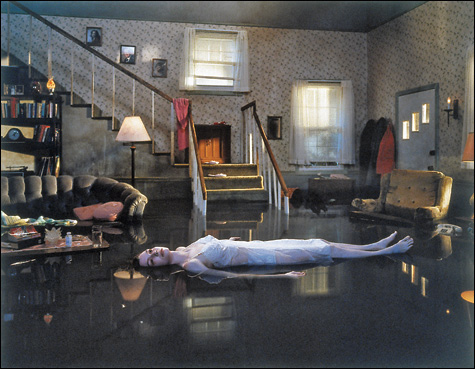All the same, the gravity of Harry’s world pulls me in, with promises of magic and invention just around the corner. Near the end, there’s Harry’s red sweater and corduroys from the first film. They’re so small . . . and cute. He was just a wee lad then. My, how we’ve all grown.

ALLURINGLY CREEPY: Gregory Crewdson’s 1991 photo of a woman floating in a flooded living room may be part of the Rose collection, but it would fit right in at the Museum of Science. |
There’s nothing like police officers roaming galleries and a squad car parked out front with lights flashing to make a museum seem exciting. The occasion was the October 28 opening of “The Rose at Brandeis,” a long-planned showcase of 120 works from the Rose collection, which includes some of the finest holdings of post-war art in New England. In January, after the collapsing economy tumbled into the school’s finances, university administrators added suspense by threatening to pawn everything here.
In July, three Rose overseers sued Brandeis to prevent the sale of the collection. So the university pledged not to sell off anything donated by the overseers or their kin and to give the state attorney general, who oversees non-profits, 30 days’ notice before pawning anything in the collection. Attorney General Martha Coakley is investigating Brandeis’s handling of its collection. Brandeis’s lawyer, former Massachusetts attorney general Thomas Reilly, tells me, “Prior to the sale of any art, it’s required that the AG review it. And we want that done.”
Meanwhile, Brandeis president Jehuda Reinharz announced in September that he would retire by June 2010. Four other administrators — including financial chief Peter French — are expected to be gone by January.
Brandeis has a proud history of protest that includes alums Abbie Hoffman and Angela Davis. Last week’s police presence seemed aimed at making sure that people pissed off by the Rose crisis didn’t do anything, well, traditional. No need to worry. Dozens of protesters wore buttons saying, “Save the Rose,” but everyone was quiet and polite.
The art remains extraordinary — if you can get past the feeling of being at a wake. The fireworks come mainly from 23 acquisitions the Rose’s first director, Sam Hunter, bought in the early 1960s with a $50,000 gift — art by Robert Rauschenberg, Jasper Johns, Claes Oldenburg, Roy Lichtenstein, Adolph Gottlieb, Morris Louis, Jim Dine, and Larry Rivers. Ellsworth Kelly’s 1962 Blue White focuses on the electric tension between a pair of kissing blue curves. Andy Warhol’s 1964 Saturday Disaster twice reproduces a newspaper photo of a bloody, fatal car wreck. Alex Katz’s 1962 The Walk #2 is a portrait of his wife Ada in a violet coat standing against a blue-black background. These works rank among the finest their artists ever made. Additional donations brought a terrific slashing lyrical 1961 Willem de Kooning abstraction inspired by the tangerine sky and blue sea near his East Hampton home. Because of their market value and the apparently limited gift restrictions, these are the pieces that are most at risk of being sold.